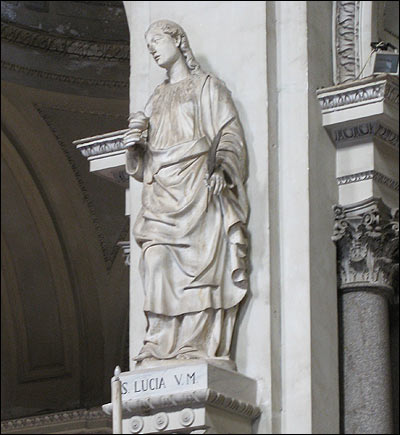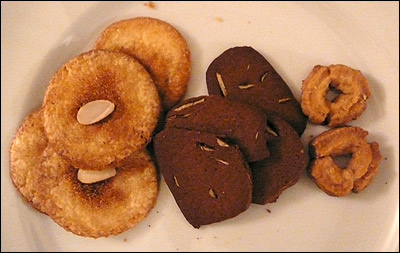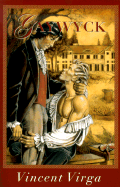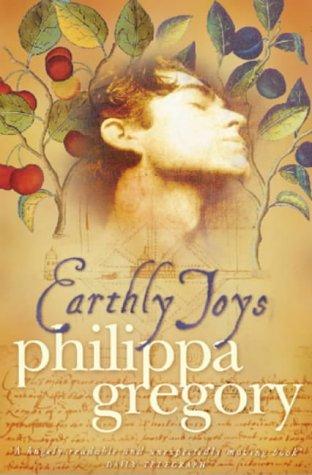Monday, December 27, 2010
The Lord of Misrule
I know for sure my kids would love for me to restart this this tradition, making one of them lord of the house for 12 days. The first thing he'd do is send me and dad to bed at 8pm sharp each night and then go on to merrily tear the house apart. Demand chocolate for breakfast, cake for lunch and sweets for supper... hmm, perhaps not, although I can't help thinking those medieval folks sure knew how to let their hair down and partee!
In the abbeys, they had the Feast of Fools starting on the 1st Jan where the priests would feast and imbibe and generally abandon all their Christian morals. A young boy or servant would be made pope or bishop for the duration and the lewd activities were at times extreme, such as eating on the altar and desecrating everything holy.
Some traditions were less pleasant in medieval times. Childermass on the 28th December was kept in remembrance of the day King Herod ordered all boys younger than 2 to be slain as he sought to kill Baby Jesus. In Europe, towns oft appointed a boy bishop for this day to be in charge of all in the city. The kids in England fared less well, it is said that many parents there would beat their children on this day as a reminder to all of King Herod's cruelty. Hmm...
Did you know that Christmas was once abolished in England? Imagine! During the puritan reign in England, Cromwell actually abolished Christmas. Didn't last long though, there are some things that just shouldn't be messed with.
Happy holidays to everyone
Thursday, December 23, 2010
My Traditional Scandinavian Christmas
By Susanna Ives
The following was written with the help of my Scandinavian in-laws. I can’t vouch for the historical accuracy of the information, but it makes for a great story.
The Scandinavian Christmas celebration starts on the first Sunday of advent. Back in the old country, the nights are long and the days are dark this time of year. Children spent their evenings making Christmas tree decorations out of paper. We bought our decorations at IKEA, but here is a star my husband made back when he was a young sprout.

IKEA also supplied our traditional Julbock or Yule Goat. The straw Yule goat dates back to times when a goat was slaughtered during the pagan Yule festival. Here is our pagan Julbock.

My husband feels I should include this link about the giant Julbocken i Gävle in Sweden.

Without fail, every December 13th, my husband and I forget Santa Lucia day. Santa Lucia is a Sicilian saint. Above is a picture of a Santa Lucia's statue that my in-laws photographed during their trip to Sicily. The Scandinavians became acquainted with her when the Normans (men of the north) occupied Sicily. Santa Lucia is associated with light during the dark wintertime.
On the morning of the 13th, the eldest daughter of the house puts a wreath of candles on her head and serves coffee and Lucia buns to her family. Below is a Santa Lucia bun made by my Danish mother-in-law.

My mother-in-law tells me Santa Lucia is a Swedish and Norwegian tradition, and she only observes the day because her husband is Swedish. However, my mother-in-law bakes delicious Santa Lucia buns and brings them to our house every year to enjoy at Christmas. She also makes traditional Danish Christmas cookies: ginger snaps, vanilla rings and almond cookies. Very tasty.

The next big day in the Christmas celebration is Lillejuleaften which means the evening before Christmas Eve. On this day, the grownups would cut down the Christmas tree, bring it inside, and decorate the branches with candles, glass bulbs, and the children’s paper decorations. In olden times, the children weren’t supposed to see the tree until Christmas Eve, however, now decorating the tree includes the entire family.
Typically, we have the tree set up before Lillejuleaften so we can concentrate on the smorgasbord. We have to shop at farmer’s markets, IKEA, and specialty grocery stores to gather various herrings, Greenland shrimp, smoked salmon, cold cuts, hard rye bread, schnapps, and a variety of cheeses including Fontina, Havarti, Port Salute, blue cheese and others. The sandwiches are open faced so the breads have to be strong enough to support loads of herring, egg, caviar and other yummy things. My father-in-law tells me that the schnapps is drunk for affect, not taste. The strong spirits warms and cheers you, but must be chased with beer, else it will burn your throat. Back in the day, there was formal drinking or open drinking at smorgasbords. Formal drinking means you must drink when the host does. My father-in-law contends this is how the Danes drank the British under the table. He also says that the advantage to formal drinking was no Viking could cut your throat as you drank. There are two sizes of schnapps glasses: large Swedish and small Danish.
At the smorgasbord, the guests make a sandwich with fish and then wait for the host to Skål, a Scandinavian toast for good fortune andhealth. Skål means drinking vessel but my family claims the term actually means drinking out of the skull of your enemy. Then the host welcomes everyone and wishes them happy glaedelig jul.
A proper smorgasbord should take several hours. The last course is coffee. Then the family and friends take a walk in the snow or such and gather a few hours later for a supper of pork loin, potatoes and red cabbage.
In Denmark, you eat a light breakfast and lunch on Christmas Eve or Jule aften because the kitchen is taken up preparing a goose stuffed with prunes and apples soaked in Port. The bird is accompanied by more potatoes and red cabbage. For dessert, you have rice, almond and cream pudding topped with hot cherry syrup. (I have a recipe if anyone is interested.) You must be very careful when you eat this dessert, for it is really a treacherous family game. You see, hidden in the pudding is one whole almond. The lucky family member who gets the almond wins a marzipan pig. In our home, in lieu of such a pig, we give out a chocolate orange.
Meanwhile, across the Kattegat in Sweden, Lutefish is served (or was). This, ummm, delicacy, is cod that has been cut by a carpenter saw and soaked in water and lye for months. Lutefish is tasteless except for the pepper and onion cream sauce and can turn your silver black. My husband gave me a little chemistry lesson on preserving fish. According to him, you have three ways to preserve fish. 1.) pickle it and make sil. 2.) let the fish rot and make surstömming. 3.) freeze dry. To reconstitute the dehydrated fish, you have mix it with lye and water and then wash away the lye.
The Swedes also had veal jelly with vinegar, pickled anchovies including the heads, and potato sausage made with pork, potato, and veal. After the meal was done and the dishes washed, glasses of Cognac were passed around.
 In Denmark, the grownups would open the door to the room housing the Christmas tree and let the children see the decorated tree with all the candles burning. Everyone danced around the tree and sang carols. (I have a CD of Danish Christmas music if you want to know the name). In our house, we light the tree candles, have a fire extinguisher handy, and keep the kids far away from the tree. We don’t keep the candles burning for very long.
In Denmark, the grownups would open the door to the room housing the Christmas tree and let the children see the decorated tree with all the candles burning. Everyone danced around the tree and sang carols. (I have a CD of Danish Christmas music if you want to know the name). In our house, we light the tree candles, have a fire extinguisher handy, and keep the kids far away from the tree. We don’t keep the candles burning for very long.
If you were Swedish, on Christmas morning you went to church at 5:30 to greet the sun while the Danes slept in. After church, the Swedes opened their gifts, ate ham for dinner and then took a nap. The Danes had another smorgasbord on Christmas and then continued to party for second Christmas day or Anden Juledag.
---------------------------------------------------------------
Susanna Ives is the author of RAKES AND RADISHES. You can learn more about her book at www.susannaives.com
- 1 quart of milk
- 1 tablespoon of sugar
- 3/4 cup of Arborio, sushi or short-grain rice
- 3/4 blanched and chopped almonds
- 1/2 vanilla bean
- 1/2 pint of chilled heavy cream.
Bring milk to a boil in a double boiler. Open vanilla bean. Add seeds and pod to milk. Add rice. Cover and let shimmer until rice is soft but not mushy. Pour rice and milk into bowl. As cooling, add sugar and almonds.
Before serving, whip heavy cream until thick. Fold in rice. Stir in whole almond.
Serve hot cherry sauce separately.
Sunday, December 19, 2010
An Outlaw's Life
 “The trouble with these moving pictures and penny-dreadful representations of outlaw life is the glamour they throw about it. No mention is made of the hunted, hounded existence, when every man’s hand is turned against you; the nights filled with dread and the days of suffering. No mention is made of the end of it all, a violent death or prison cell." Cole Younger
“The trouble with these moving pictures and penny-dreadful representations of outlaw life is the glamour they throw about it. No mention is made of the hunted, hounded existence, when every man’s hand is turned against you; the nights filled with dread and the days of suffering. No mention is made of the end of it all, a violent death or prison cell." Cole YoungerThomas Coleman Younger was born in 1844. His father, Henry Washington Younger was an ambitious businessman and his mother, Bursheba Fristoe, was a judge’s daughter. They were married in 1830. During their marriage the affluent couple was very much a part of Jackson County social circles. Henry’s business interests included a ferry line, a dry goods operation and a livery. He was elected mayor of Harrisonville and by 1856, he owned several thousand acres of land. He and Bursheba were also prolific when it came to children. They had nine daughters and five sons.
Cole was a high-spirited, outgoing boy who loved to hunt and fish. He and his siblings were popular at school. Education was very important to the Youngers and at the urging of his older brother, Richard, Cole applied to Chapel Hill College. Richard died from a sudden illness at age 22 and in 1861, Cole’s life took on a new direction, far from a college campus. One that would last the rest of his life and make a legend of him. Cole summed this up in his book by saying: “Political hatreds are always bitter, but none were ever more bitter than those which existed along the border line of Missouri and Kansas during my boyhood in Jackson county in the former state from 1850 to 1860. These hatreds were soon to make trouble for me of which I had never dreamed”.
It was the fall of 1861 and Cole and his younger brother, Jim, accompanied their two sisters to a dance in Harrisonville. Irvin Walley, a member of the militia stationed there, tried to force one of Cole’s sisters to dance with him. Cole came to her defense. Walley demanded to know where Quantrill was and called Cole a liar when he said he did not know Quantrill's location. They fought until other men at the party intervened.
Cole’s father was worried for his son’s safety after he heard about the fight and he sent Cole away. Walley came to the Younger home with his troops, hunting for Cole who was now accused of being a spy for Quantrill. In response, Cole armed himself, which put him in direct violation of Fremont’s orders that no man, not affiliated with a recognized militia group in Missouri, bear arms.
Thus, at seventeen, Cole Younger was now an outlaw
He joined up with his brother-in-law, John Jarrette, under Quantrill and became a Missouri guerrilla. During this era in his life, he met Frank James and they formed a life-long friendship.

During the war, Cole’s father was ambushed and murdered. When the war ended Henry’s estate was in shambles. Cole tried his hand at cattle ranching in Texas, which he loved but his brothers hated. For a while, he and Jim worked as census takers. Finally they returned to Missouri and joined Frank James and his younger brother, Jesse, to create what would become the most famous outlaw gang of all time. In his book, Cole stated "I have been shot between twenty and thirty times and am now carrying over a dozen bullets which have never been extracted..."
The blotched bank robbery in Northfield, Minnesota landed thirty-two year old Cole in Stillwater prison for twenty-five years. During this time, Cole and his two brothers were model prisoners. Cole worked as the prison librarian, and later when a new prison hospital was built, he became the head nurse. In July of 1901, Cole and his brother, Jim, were released. Their kid brother, Bob, had died in prison.
Jim committed suicide after his release (some say due to a broken heart), and Cole returned to Missouri after he was granted a pardon by the state. The future held promise for the former outlaw, who would make the most of his fame.
Cole was reunited with his former comrade, Frank James, who had been acquitted of all crimes after his brother’s murder. Cole and Frank embarked upon a business venture, The Great Cole Younger and Frank James Wild West Show. Cole, who claimed he wanted to set the record straight, wrote an autobiography, titled The Story of Cole Younger by Himself. The book was published in 1903. He denies being involved in any crimes other than the Northfield Bank Robbery and always insisted Frank and Jesse James were not involved in that robbery.
In 1909, Cole, who loved the spotlight, put together a lecture tour called “What Life Has Taught Me” emphasizing living a good and decent life. He traveled the country speaking to audiences about what he felt were important lessons he had learned from his experiences. Cole may have been one of the first motivational speakers.
By 1915, his health was failing. He had no family, other than his sisters. Although he had always been a favorite with the ladies, he never married. His old friend, Frank James died on Feb 18, 1915 and it was said Cole retreated to his room when he was told the news and sat alone the rest of the day. A year later, on March 21st, Cole Younger passed away quietly in bed, and, a century later, Cole continues to live on in movies and books, including my own novella, Almost An Outlaw.
Sources and recommended books about Cole: The Outlaw Youngers by Marley Brant and The Story of Cole Younger by Cole Younger.
Thursday, December 16, 2010
Inspire Me!
 |
| Colin Firth in Pride & Prejudice |
 |
| Sean Bean as Sharpe |
(Come on people. Gavotte with me!)
And yes, do give me poetry!
Tell me you can read this without getting your imagination all fired up!
Of cloudless climes and starry skies;
And all that's best of dark and bright
Meet in her aspect and her eyes:
Thus mellowed to that tender light
Which heaven to gaudy day denies.
One shade the more, one ray the less,
Had half impaired the nameless grace
Which waves in every raven tress,
Or softly lightens o'er her face;
Where thoughts serenely sweet express
How pure, how dear their dwelling place.
And on that cheek, and o'er that brow,
So soft, so calm, yet eloquent,
The smiles that win, the tints that glow,
But tell of days in goodness spent,
A mind at peace with all below,
A heart whose love is innocent!
 |
| Keira Knightley as Elizabeth Bennett |
So those are some of the places I get my inspiration.
And what's your favorite read?
Taryn Kincaid is the author of an erotic paranormal romance, Sleepy Hollow Dreams. Her debut historical, Healing Hearts, a Regency romance, will be released by Carina Press, February 28. Please come visit her blog at http://dreamvoyagers.blogspot.com/. Her free-read Christmas story, I'll Be Home for Christmas, will be up all month!
Monday, December 13, 2010
Some random thoughts on male/female sex in historical romance
I adore reading love scenes in romance novels. Back in the days before e-books, I used to open my new print books toward the middle and search for the passage where the hero and heroine first indulged in the ultimate. It’s harder to do that in e-books, which is probably a good thing. There’s a reason for the build-up, and that is to make the pay-off all the sweeter, and my enjoyment is enhanced by the foreplay.
When I began writing, I knew in my bones that I’d make my stories as hot as possible within the constraints of the genre. After twenty years, I’ve written a lot of sex in a lot of time periods. Please, indulge me in a few random thoughts.
Random thought #1: Species homo sapiens sapiens hasn’t changed much physically for tens of thousands of years and probably won’t change any more for the next dozens of millennia. That means that people’s sex drives haven’t increased or decreased throughout our history. The same things that feel really good now felt really good when we lived in caves, ancient Roman villas, the American plains, medieval castles, or stately houses on Hyde Park. People explored and experimented in ages past the same way we do today. There’s not much new under the sun. Granted, under periods of deprivation people had less interest in sex, but in times of plenty, people messed around with the same creativity and vigor we do now.
I come from the “free love” generation of the 60‘s and 70‘s. We think we invented sex and everyone who came before was repressed, closed-minded, and ignorant. The truth is that our foremothers had the same urges we did and often acted on them. The main difference is that they had a lot more “early” babies because they didn’t have as many contraceptive options as we did. (Although they had more of those than we give them credit for, too.)
We often assume that progress of sexual liberation goes in a linear fashion from repressed to open as we go forward in time. In fact, freedom of sexual expression goes in fits and starts. Some of the ribald passages in Shakespeare’s works would make a modern miss blush. Even within the last 40 years, the culture of the United States has become more subdued sexually than when I was young. People of younger generations often express surprise at some of the things that come out of my mouth and laugh with disbelief at some of my stories. (And no, I’m not repeating any of them here.)
Random thought #2: If you’re writing in a sexually repressed period such as my favorite, the Victorian, your hero should be conscious of the dangers of sex outside of marriage for his heroine and should be willing to take responsibility for his actions. In other words, he shouldn’t ruin her reputation and/or leave her to take care of an unexpected pregnancy.
Unless your heroine is independently wealthy, a rather iffy prospect given the property laws at the time, the quality of her adult life may depend on her marriage. If her reputation has been tarnished, she’ll have a difficult time making an advantageous match. Furthermore, as authors, we don’t often include contraception in our historical stories. If she becomes pregnant, he needs to support his child. If he’s a nobleman, the child may very well be his heir.
Consequently, it’s my feeling that a romance hero who’s taken the heroine’s virginity should immediately offer, or demand, to marry her. I can hear you saying, “But, Alice, you just said that people are the same across centuries. A Victorian man is no more likely to want to marry a woman because he’s slept with her than a modern man.” To which I say, that’s true, but we’re not talking about an average man here. We’re talking about a romance hero. Though he may be dark, difficult, and tortured, he’s always honorable.
Of course, if the heroine has already lost her virginity and the hero isn’t her first lover, the burden of responsibility doesn’t fall on his shoulders so heavily. However, he should still assume responsibility for any child she may have conceived.
Random thought #3: Making love to the virgin. I don’t know about you, but my first experience was…ahem…shall we say…not the stuff of romance novels. As a reader, I can suspend disbelief about the joys of the first intercourse to a certain extent because I’ve followed all the breathless kisses and intimate caresses that lead up to the first love scene. Still, I need to see the hero put some effort into making sure the heroine experiences the minimum of pain and the maximum of pleasure. A few touches to the naughty bits and then slam-bam-thank-you-ma’am isn’t going convince me that he could truly satisfy her. This isn’t the place for a quickie. If at all possible, give them the setting, adequate time, and especially the hero’s attention to the right places on her body for a long and satisfying scene.
I've read too many books that were otherwise enchanting only to be disappointed with the first love scene. If the hero doesn't put a lot of thought into making the sex really, really good for the woman he loves (or will soon come to love), I fall out of love with him a bit. Once that happens, the story loses some of its shine. Make the encounter good, and I’ll hang in there, enjoying every delicious moment.
Alice Gaines loves hot, hot historical romance. Her book, Miss Foster’s Folly, was released by Carina as part of the launch in June of 2010. A second historical, Always a Princess, is in the works.
Thursday, December 09, 2010
Christmas Dinners with Wellington's Army

Christmas hadn't yet become the lavish production it is today even among those safe at home in Britain, but the officers of the army in the field entertained one another with the best dinners that could be obtained. In 1812 two turkeys formed the principal part of the holiday feast for Wellington and his guests, while one year a group of artillery officers had "soup, salt fish, roast beef, boiled beef, mutton, vegetables, etc., etc., and a remove of turkey, fowls, ham and tongues--afterwards pastry." After dinner they lived up to the hard-drinking standard of the times with toasts to "All absent friends, the King, the Prince Regent of Portugal, to England, to Lord Wellington, and the British Navy, to name only the principal toasts."
In 1810 some of the officers even had something that would've been all but unheard of in England at the time--a Christmas tree. As many of you may know, Christmas trees got their start as a German custom and didn't become generally popular in Britain or North America until the Victorian era a few decades later. But the British army of the Napoleonic era included a King's German Legion composed of Hanoverian troops (since at that point the King of England was also the Elector of Hanover, which is now part of Germany). And the officers of the KGL kept up German tradition and had a tree--a lemon tree, decorated all over with oranges and candles.
So much for the officers, but what about the enlisted men? We don't have as many records, because so much of our source material is officers' correspondence and diaries. But we know that in 1812 the colonel of Gordon Highlanders ordered his company commanders to "give their men as good dinners as they possibly can tomorrow...as it is Christmas Day," and Captain John Cooke of the 43rd Light Infantry provides the following description of Christmas Night, 1813:
Just before dark, while passing a corporal's picquet, an officer and myself stood for a few minutes, to contemplate a poor woman, who had brought her little pudding, and her child, from her distant quarters, to partake of it with her husband, by the side of a small fire kindled under a tree.
For all of these details I'm indebted to Antony Brett-James' Life in Wellington's Army. If you're writing about the Peninsular War, or even just writing a hero with the war in his past, it's well worth getting from interlibrary loan or hunting down a used copy (generally cheaper on abebooks than Amazon, incidentally).
Monday, December 06, 2010
Introduction: Erastes and Gay Historical Fiction
The Historical Novel Society defines Historical Fiction as: “a novel must have been written at least fifty years after the events described, or have been written by someone who was not alive at the time of those events (who therefore approaches them only by research).”
That would mean neither Maurice (E.M Foster) nor The Charioteer (Mary Renault) could be included within this definition, and many more besides, which would be a great shame. My personal (and probably erroneous) view of gay historical fiction is any book which deals with gay themes in the past, whether they were contemporarily written in that time or not.
With the changes in the acceptance of homosexuality on the world stage, (looking specifically at Stonewall and the Wolfenden Report,) it seems difficult to say that gay historical fiction can only qualify if it starts in the 1950’s. In my opinion at least, events of the 50’s and 60’s are just as interesting and relevant from a historical perspective as was gay society in 1900 or 1800.

When it comes to textbooks on the subject of gay history there are literally hundreds of tomes, some much drier than others. Possibly unsurprising, there is only one major work, that even explores the genre of gay historical fiction. (Gay and Lesbian Historical Fiction by Norman W Jones). However, it is almost unreadable, and doesn't make the genre accessible or appealing, as far as I'm concerned! Better far to read the wonderful web resource of Rictor Norton!
I find it odd that so few people have explored the many stories of gay men in the past, whether in fictionalized biography for famously gay men such as Byron or Michelangelo, or for purely fictional inventions, when there is such a huge catalogue of heterosexual historical romance.
Historical Merit and RationalisationBut some have explored those stories, and more are now doing so than ever before. There’s some argument as to what the first actual gay historical novel was, going by the Historical Novel Society’s rules, and I would have to say that it was probably Mary Renault with her classical tales of Ancient Greece. Of Alexander the Great. (Fire from Heaven, The Persian Boy, Funeral Games) Her wonderful The Charioteer was written in the 1950’s but only dealt with an era a few years back, the early part of the 2nd World War and as I said - it wouldn’t qualify under the HNS rules. There were others which shone brightly when they first appeared (but were published and considered as pulp by some, rather than as classics) such as Richard Amory’s strange and possibly substance-fuelled American Frontier stories (Listen, the Loon Sings; Willow Song and others.)
Renault was a solid and respected historian. Her work was read very widely outside the gay community. It was easy, perhaps (especially as any sexual content had to be almost completely coded and hidden away) for people to read these books and pat themselves on the back for reading such perfectly rendered and exquisitely researched books by a professor of the classics. It was educational. It was easy, perhaps, to ignore the obvious love affairs of Alexander. And anyway – it’s Classical! They all did that sort of thing, didn’t they?
The Birth of Gay Gothic
 Gaywyck by Vincent Virga (1980) probably takes the accolade of the first modern gay historical romance. With its obvious nod to the traditional Gothic novel, in Gaywyck we find mad relations, hidden rooms, an innocent driven to the point of madness and danger lurking behind every door. Purple it certainly is (and its less popular sequel Vadriel Vail is even more so) but it broke the ice. Here was a story of gay men in the style of the Romance Novel that had been bought and devoured by millions of women worldwide. It should have opened the floodgates, but possibly even in 1980 it was a little ahead of its time.
Gaywyck by Vincent Virga (1980) probably takes the accolade of the first modern gay historical romance. With its obvious nod to the traditional Gothic novel, in Gaywyck we find mad relations, hidden rooms, an innocent driven to the point of madness and danger lurking behind every door. Purple it certainly is (and its less popular sequel Vadriel Vail is even more so) but it broke the ice. Here was a story of gay men in the style of the Romance Novel that had been bought and devoured by millions of women worldwide. It should have opened the floodgates, but possibly even in 1980 it was a little ahead of its time.
The genre didn’t die completely, but it disguised itself yet again, this time as literature and romance. Respected authors wrote books in the genre - such as Beryl Bainbridge (Master Georgie), Tom Spanbauer (The Man Who fell in love with the Moon) and mainstream popular authors such as Philippa Gregory (famous for her traditional historicals such as The Other Boleyn Girl) wrote Earthly Joys about the decadent Duke of Buckingham. Historical readers and Romance readers bought them, literature lovers bought them, and so did people  looking for gay fiction.
looking for gay fiction.
But still the floodgates didn’t break. More titles began to emerge, and more notably they were adventures and romances. Regency gentlemen, English sailors and pirates. However, for the main part all of these books were (and still are) published by small presses such as Linden Bay Romance, Torquere Books or Cleis Press.
When Brokeback Mountain arrived I, for one, thought that things would change and the publishers (who were still declaring that lesbian historicals were hot (Sarah Waters) but there wasn’t any market for gay historicals) would see the light.
But it still hasn’t really happened.
However, the future looks bright. There are more and more people writing it, and more and more people reading it.
Who are these people?
Surprisingly, just about anyone. Straight men, gay men, straight women, lesbians, transsexuals. Anyone with a passion for history and the need to tell (or to read) a good story. I believe that the majority of people reading gay romance are women right now, but there are (evidenced by my post bag) gay men in growing numbers who are not afraid to admit that they really enjoy what is generally termed now as a breeches, codpiece or a waistcoat ripper.
(or to read) a good story. I believe that the majority of people reading gay romance are women right now, but there are (evidenced by my post bag) gay men in growing numbers who are not afraid to admit that they really enjoy what is generally termed now as a breeches, codpiece or a waistcoat ripper.
With the advent and popularity of e-books, (which turn what might be an embarrassing (for some) purchase in a bookstore into an anonymous and instant gratification,) the gay historical novel seems to be pulling itself away from its Gothic and classical beginnings and is exploring other eras. From Saxon or Arthurian warriors (Mel Keegan) to the dangerous 19th Century, the Age of Sail with its infamous Article 29 (Lee Rowan, Alex Beecroft) through the Regency and into the Victorian era. Writers are researching and producing stories.
I was so thrilled when I found that Harlequin--under the Carina imprint--was dipping its toe into the water and was including gay romances, both contemporary and historical, in their new venture. Hurrah!
What fascinates, some say, is the difference between a male/female relationship and the male/male. The fact that gay love has always existed as long as love has – and how men dealt with that in each era, and each country. The fact that men look good in period dress (and out of it) and that carriages and pistols and swords are sexy. The fact that they don’t have to have a submissive female-ish character at all, but both can be dominant and masculine. The challenge of creating a “Happy Ever After” or at least a happy for now.
The Future
More. I am convinced that we are about to see an explosion of gay historical fiction over the next few years. New e-books are appearing almost daily, most epublishers that accept GLBTQ accept the genre as a matter of course. Recently, STARbooks, one of the larger gay print publishers, has put a specialist call out specifically for gay historical novels and anthologies and Running Press are actively seeking gay historical fiction prior to 1900.
It can only get better. It will make me busy as I attempt to keep track of it all, but it will make me happy.
My first book with Carina "Muffled Drum" will be coming out with Carina in the Spring of 2011 - so I can't share the cover with you yet, but I hope you'll try it. It is set in the Austro Prussian war of 1860 and has lots of men in gorgeous uniforms in it... *tempts*
so I can't share the cover with you yet, but I hope you'll try it. It is set in the Austro Prussian war of 1860 and has lots of men in gorgeous uniforms in it... *tempts*
Erastes
www.erastes.com
Erastes is the penname of a female author of gay historical fiction who lives in the UK. Her first novel Standish was published in 2006 (Gay Regency), and her second novel, Transgressions was one of the flagship titles for Running Press's gay historical romance line in 2009. Her third novel "Mere Mortals" will be published by Lethe Press in 2011. As well as "Muffled Drum" she has had five other novellas in print, details can be found of all the above on her website.
She's the proud owner of Speak Its Name, the only blog dedicated purely to reviews of gay historical fiction.




